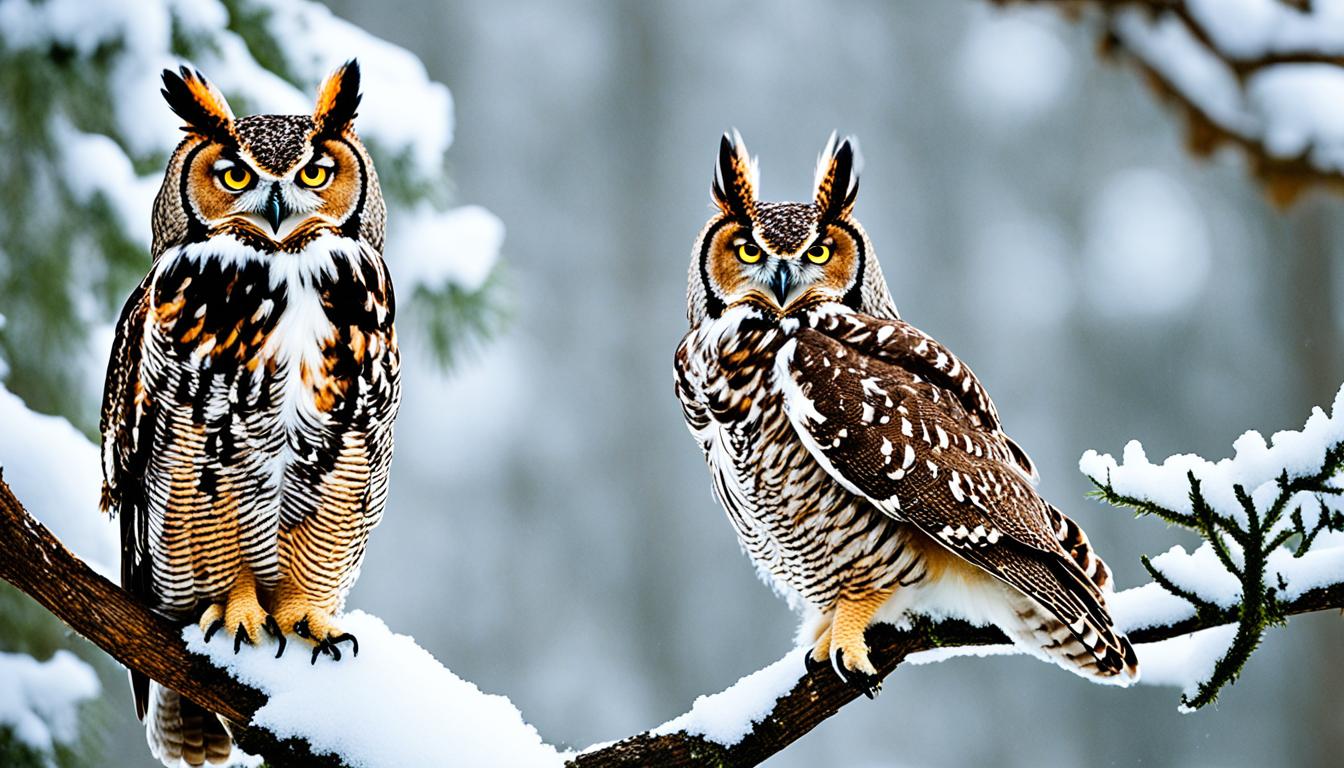When it comes to bald eagles, one of the most commonly asked questions is whether they are warm-blooded or cold-blooded animals. Understanding the answer to this question can provide insight into the unique physiology and behavior of these majestic birds.
In this article, we’ll explore the topic of bald eagle body temperature and temperature regulation, examining the scientific evidence and discussing the implications of warm-bloodedness for these birds. By the end of this article, you’ll have a clear understanding of whether bald eagles are warm or cold-blooded and what this means for their survival and behavior.
Key Takeaways:
- Bald eagle body temperature is an important aspect of avian physiology and thermoregulation.
- Understanding the classification of bald eagles as warm or cold-blooded animals can shed light on their unique behaviors and adaptations.
- With a clear explanation of bald eagle temperature regulation mechanisms and scientific evidence, we can determine whether they are warm or cold-blooded animals.
Understanding Warm-Blooded and Cold-Blooded Animals
Before we dive into the fascinating world of bald eagles and their temperature regulation, let’s first take a moment to understand the difference between warm-blooded and cold-blooded animals.
Warm-blooded animals, also known as endotherms, maintain a relatively constant body temperature regardless of their environment. These animals use their metabolism to generate heat, which is then regulated by physiological mechanisms to keep their body temperature within a narrow range.
In contrast, cold-blooded animals, or ectotherms, rely on external sources of heat to regulate their body temperature. These animals cannot generate heat internally, so their body temperature fluctuates with the temperature of their surrounding environment.
Understanding Warm-Blooded and Cold-Blooded Animals
Endotherms and ectotherms represent two very different approaches to temperature regulation that have different advantages and disadvantages. Endotherms can maintain a high level of activity in a wide range of temperatures, but require a lot of energy to do so. Ectotherms, on the other hand, have a lower metabolic rate and require less energy, but are limited by their external environment.
“Warm-blooded animals, also known as endotherms, maintain a relatively constant body temperature regardless of their environment.”
- Endotherms include mammals and birds, while ectotherms include reptiles, amphibians, and fish.
- Interestingly, some animals, such as certain species of sharks and tuna, are able to regulate their body temperature to some degree, making them partially endothermic or “warm-bodied”.
Now that we have a basic understanding of temperature regulation, let’s explore how bald eagles adapt to their environment to maintain a stable body temperature.
Avian Temperature Regulation
Like all birds, bald eagles have a unique internal physiology that allows them to regulate their body temperature. Birds, including eagles, are endothermic, which means that they can generate their own body heat through metabolic processes.
One of the adaptations that birds have is the presence of feathers, which provide insulation and help maintain a stable body temperature. Birds can also adjust their metabolic rate and behavior in response to changes in temperature, allowing them to conserve or dissipate heat as needed.
| Bird Physiology | How it relates to temperature regulation |
|---|---|
| Feathers | Provide insulation and help maintain a stable body temperature. |
| Metabolic rate | Birds can adjust their metabolic rate in response to changes in temperature, allowing them to conserve or dissipate heat as needed. |
The regulation of body temperature in birds, including bald eagles, is critical to their survival and ability to thrive in a variety of environments.
The Blood Circulation in Bald Eagles
Like all birds, bald eagles have a unique circulatory system that helps them maintain a stable body temperature. Unlike mammals, birds have a one-way circulation system that moves blood through their bodies in a continuous loop.
The key to this system is the four-chambered heart, which is more efficient at pumping oxygen-rich blood to the body’s organs and tissues. The heart’s left and right sides are separated by a wall of tissue, ensuring that oxygen-rich and oxygen-poor blood never mix. This is an essential adaptation for birds as it allows them to maintain a consistent body temperature, even while flying at high altitudes.
| Bird Circulation System | Mammal Circulation System |
|---|---|
| One-way loop | Two-way loop |
| Four-chambered heart | Three-chambered or four-chambered heart |
| No mixing of oxygen-rich and oxygen-poor blood | Mixing of oxygen-rich and oxygen-poor blood in some species |
In addition to the heart, bald eagles have several other adaptations that contribute to their thermoregulation abilities. For example, their arteries and veins are often placed in close proximity to one another, allowing for the transfer of heat from arteries carrying warm blood to veins carrying cooler blood. This helps maintain a consistent internal body temperature even in cold temperatures.
Facts About Bald Eagle Blood
- Bald eagles have a higher number of red blood cells than humans.
- They also have a higher percentage of hemoglobin, the protein in blood that binds to oxygen, allowing them to extract more oxygen per breath.
- Bald eagle blood is also known to clot faster than human blood.
“The circulatory system of birds, particularly their heart, is an amazingly efficient adaptation to their unique physiological demands. It allows them to remain active and fly at high altitudes with ease, all while maintaining a consistent body temperature.”
Body Temperature of Bald Eagles
Now that you have a better understanding of warm-blooded and cold-blooded animals, you may be wondering where bald eagles fall on this spectrum. The truth is, bald eagles are warm-blooded animals, also known as endothermic animals. This means that they are able to regulate their internal body temperature independently of the environment around them.
The average body temperature of a bald eagle is around 106 degrees Fahrenheit (41 degrees Celsius). This is similar to the body temperature of other warm-blooded birds, such as chickens and turkeys. In contrast, cold-blooded animals, such as reptiles and amphibians, have body temperatures that fluctuate with the temperature of their surroundings.
Evidence of Warm-Bloodedness in Bald Eagles
There is scientific evidence to support the classification of bald eagles as warm-blooded animals. For example, researchers have measured the metabolic rates of bald eagles and found that they have a high rate of energy production, which is a characteristic of warm-blooded animals.
In addition, bald eagles have several adaptations for thermoregulation, which further support their warm-blooded classification. These adaptations include specialized feathers that help regulate body temperature, as well as the ability to shiver to generate heat in colder environments.
Overall, the evidence strongly suggests that bald eagles are warm-blooded animals, capable of maintaining a constant internal body temperature regardless of their external environment.
Evidence of Warm-Bloodedness in Bald Eagles
Scientists have studied the physiology of bald eagles extensively, and their findings reinforce the idea that these magnificent birds are warm-blooded animals.
In fact, the evidence suggests that bald eagles have many of the same warm-blooded characteristics as mammals.
For example, bald eagles have a high metabolic rate, which is one of the defining features of warm-blooded animals. This means that they can generate and maintain body heat even when the external temperature is low.
Additionally, bald eagles have a four-chambered heart, which is another trait shared with warm-blooded animals. This ensures efficient circulation of oxygenated blood throughout the body, supporting their high metabolic rate.
Perhaps most compellingly, bald eagles have been observed panting when they are hot, a behavior typically associated with warm-blooded animals.
This behavior serves to dissipate excess heat and reduce their body temperature, further confirming their warm-blooded status.
Adaptations for Thermoregulation in Bald Eagles
Now that you understand the basics of avian temperature regulation and the bird circulation system, let’s dive into how bald eagles have adapted to maintain their body temperature. As warm-blooded animals, bald eagles have a constant internal body temperature that is higher than their surroundings, which allows them to live in a wide range of climates.
One of the most important adaptations for thermoregulation in bald eagles is their feather insulation. Eagles have two types of feathers: down feathers and contour feathers. Down feathers are soft and fluffy and provide a layer of insulation to keep heat close to the skin. Contour feathers are stiffer, and they help the bird to remain aerodynamic during flight. Bald eagles have a layer of down feathers close to their skin that helps to retain heat and keep them warm in cold weather.
| Adaptation | Description |
|---|---|
| Feather insulation | A layer of down feathers close to their skin helps to retain heat and keep them warm in cold weather. |
| Varied blood vessel sizes | Eagles can regulate blood flow to different parts of their body to conserve or release heat as needed. |
| Shallow breathing | Eagles can slow their breathing rate to reduce heat loss through respiration. |
In addition to feather insulation, bald eagles also have varied blood vessel sizes that they can use to regulate blood flow to different parts of their body. When it’s cold outside, eagles can restrict blood flow to their legs and feet, which reduces heat loss through exposed skin. Conversely, when it’s hot, they can increase blood flow to these areas to release heat.
You may be surprised to learn that bald eagles can also conserve heat by slowing their breathing rate. By breathing shallowly, they reduce the amount of air passing over their lungs and mouth, which can lower heat loss through respiration. This adaptation is particularly useful in cold weather when the eagle needs to conserve as much heat as possible.
Overall, these adaptations for thermoregulation allow bald eagles to maintain a stable body temperature in a wide range of environments. By keeping warm-blooded, they can remain active and alert, making them efficient hunters and successful predators in their ecosystems.
Comparison to Other Birds and Animals
While bald eagles are warm-blooded animals, their temperature regulation mechanisms differ from those of other bird species and animals.
Compared to mammals, birds have a higher body temperature and a faster metabolic rate. However, unlike mammals, birds do not have sweat glands to regulate their body temperature. Instead, they rely on other adaptations such as panting and regulating blood flow to their extremities to dissipate heat.
| Bird Species | Temperature Regulation Mechanisms |
|---|---|
| Hummingbirds | Hummingbirds are capable of regulating their body temperature in extreme temperatures through panting and fluttering their wings to generate heat. |
| Owls | Owls have specialized feathers that allow for silent flight, which also helps with temperature regulation. They also have a unique blood circulation system that helps to prevent heat loss through their feet, which are often exposed. |
| Penguins | Penguins have a thick layer of blubber and a countercurrent heat exchange system in their legs that helps to conserve heat. They also huddle together in groups to share warmth. |
Compared to other bird species, bald eagles have a unique ability to regulate their body temperature through behavioral adaptations such as perching in sun or shade, adjusting their posture, and fluffing their feathers for insulation. They also have specialized blood vessels that help to regulate their body temperature and keep their vital organs warm.
Implications of Warm-Bloodedness in Bald Eagles
Now that we know bald eagles are warm-blooded animals, let’s explore why this is important. Being warm-blooded allows bald eagles to maintain a consistent body temperature, which is crucial for their survival.
For example, bald eagles can live in a variety of habitats, from the frozen tundras of Alaska to the hot deserts of Arizona. Their warm-bloodedness allows them to adapt to these extreme environments and maintain their normal body temperature despite the external temperature fluctuations.
Additionally, being warm-blooded allows bald eagles to have more energy and endurance than cold-blooded animals, which rely on external sources of heat to regulate their body temperature. This is particularly important for bald eagles, as they are top predators and need to be able to hunt and fly for extended periods of time.
Overall, the warm-bloodedness of bald eagles plays a critical role in their survival and ability to thrive in a range of environments.
Conclusion
After exploring the various aspects of avian temperature regulation, it is clear that bald eagles are warm-blooded animals. The evidence supports the fact that they have the ability to regulate their body temperature through adaptations such as feathers, metabolism, and blood circulation. These adaptations enable them to maintain a stable body temperature, which is crucial for their survival in the wild.
Being warm-blooded gives bald eagles an advantage in terms of behavior and hunting strategies. They have the ability to hunt in colder temperatures, which allows them to expand their range and forage for food more effectively. Additionally, their warm-bloodedness enables them to fly efficiently at high altitudes and for long distances.
Overall, understanding the temperature regulation mechanism of bald eagles and their warm-bloodedness is important for their conservation and protection. Bald eagles are an important symbol of the United States and are an essential part of the ecosystem. By preserving their habitat and protecting them, we can ensure that future generations will continue to benefit from their majestic presence in the wild.
Can Bald Eagles Fly Long Distances Due to Their Warm-Blooded Nature?
Bald eagles, known for their majestic appearance, often soar across vast distances due to their warm-blooded nature. With the ability to maintain a constant body temperature irrespective of external conditions, these magnificent birds can fly for remarkable durations. In fact, it’s astounding to witness how long can bald eagles fly, effortlessly traversing hundreds of miles during their flight. As true master aviators, bald eagles exemplify the wonders of nature’s design.
FAQ
Q: Are bald eagles warm or cold blooded?
A: Bald eagles are warm-blooded animals.
Q: What is the difference between warm-blooded and cold-blooded animals?
A: Warm-blooded animals, like bald eagles, can regulate their body temperature internally, while cold-blooded animals rely on external sources of heat to regulate their body temperature.
Q: How do birds, including bald eagles, regulate their body temperature?
A: Birds have unique adaptations for thermoregulation, including feathers, specialized blood vessels, and behaviors such as sunbathing or fluffing their feathers to trap air for insulation.
Q: How does blood circulation work in bald eagles?
A: Blood circulation in bald eagles, as in other birds, follows a similar pattern to mammals, with a four-chambered heart pumping oxygenated blood to the body and deoxygenated blood to the lungs.
Q: What is the average body temperature of bald eagles?
A: The average body temperature of bald eagles is around 104 degrees Fahrenheit (40 degrees Celsius).
Q: Is there scientific evidence that supports bald eagles being warm-blooded?
A: Yes, scientific studies have shown that bald eagles actively regulate their body temperature and exhibit physiological characteristics consistent with being warm-blooded animals.
Q: What are the adaptations that help bald eagles maintain their body temperature?
A: Bald eagles have adaptations such as a high metabolic rate, specialized feathers for insulation, and the ability to adjust blood flow to different parts of their body to conserve or dissipate heat.
Q: How do the temperature regulation mechanisms of bald eagles compare to other birds and animals?
A: Bald eagles share similar temperature regulation mechanisms with other bird species, but they may have specific adaptations that are unique to their habitat and lifestyle.
Q: What are the implications of being warm-blooded for bald eagles?
A: Being warm-blooded allows bald eagles to maintain a constant body temperature, enabling them to engage in active behaviors, hunt efficiently, and survive in various environments.
Q: In conclusion, are bald eagles warm or cold blooded?
A: Bald eagles are warm-blooded animals.











